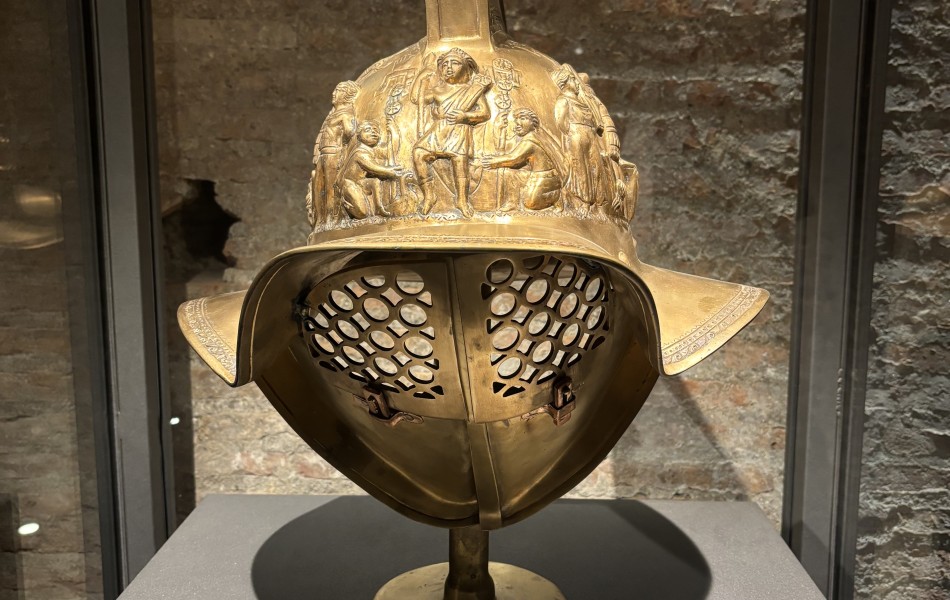Arena and Power: How the Roman Gladiators sold out the Colosseum
The Ancient Show Business: Gladiators and the Charm of the Roman Arena, effective ingredients of the most beloved Entertainment in Imperial Rome

07 November 2024
Rome Travel GuideThe gladiator games, known as munera, were clashes between men armed differently from each other and, along with chariot racing, formed the favorite entertainment for Romans in ancient times. If you want to experience the excitement of gladiators plan your trip to Rome and join our Guided Audio Tour of Colosseum at your own pace. But what did these games really involve?
Munera: The Price of Glory in Ancient Rome
Let's start with the name. The term munera brings to mind another word: remunerate. Yes, to pay back in some way, to return a service. The word munus, the plural of which is munera, was a way for prominent city figures to provide a public service out of their own pocket—both to gain the people's favor and celebrate their own status, but also because achieving this position required an obligation to “give back” to the state and the people. Essentially, if you were wealthy in Rome, you would be expected to spend money on public entertainment. The origins of gladiator games are somewhat lost in time: we know that among the Etruscans, deadly clashes between men were a significant event, and even among the Romans, these fights initially took place as part of religious or funeral ceremonies
For the Roman games, the earliest known beginning is in 254 BCE, when Decimus and Marcus Brutus organized gladiator games in the Forum Boarium to honor their father’s funeral. The association of gladiators with the amphitheater, this was the name of the building for these spectacles, was developed later and to have the first permanent amphitheatre we have to wait until 70 BC, when it was built in Pompeii. Exactly one century later the construction of the Colosseum began. However, this type of activity accompanied Roman society at least from the height of the Republican age, and then gradually became the most popular form of entertainment in the Imperial age.
So were munera in imperial Rome really that important? Can we compare the winning gladiators to our football champions? Were they really fights to the death and without rules? Let us look at one topic at a time.
Bread and Circuses: The Importance of Gladiator Games in Ancient Rome
How important were they? First of all, the munera were essential for those in power: by interacting with the people, they could gauge the public's mood, while those who offered the games could gain the people’s favor and increase their own prestige. Furthermore, they were generally a tool to placate the population, as Juvenal famously stated with the phrase panem et circenses (bread and circuses).
The people were passionate about these games, so much so that fans divided into two main factions: the parmularii and the scutarii. The former supported gladiators armed with small shields called parmula, while the latter favored classes of gladiators wielding a large scutum. There’s a famous episode reminiscent of today’s “ultras” fights, which took place in Pompeii in 59 CE: “a trivial incident provoked a brutal massacre between the colonists of Nuceria and Pompeii during a gladiator show […] They began by hurling insults in the manner typical of provincial towns, then took up stones, and finally weapons.” Even emperors had their own favorites, as we know that Caligula and Titus supported the Thraex, or Thracian gladiators.
The munera was a spectacle that moved substantial sums of money in society: slave merchants sold slaves to lanistae (trainers), who invested in training gladiators and then rented them out for shows; there was also a complex trade in wild animals, etc.
The protagonists of these games were, of course, the gladiators: although the name suggests the term gladius (sword), gladiators actually used a wide variety of weapons, both melee and ranged. Some gladiators have left their mark on history with their feats, like Spartacus, Spiculus, and Flamma, while others we know through graffiti, like Vindicomus, Amazon, and Achillia. Yes, Amazon and Achillia were female names, as arena fights were not exclusively male. Women, known as foeminae, also fought in the arena: they participated in hunts during the Colosseum’s inauguration, and we know of a class called the foeminae murmillo, which suggests that other female gladiator classes like the Thracian or Hoplomachus might have existed as well.
Gladiators: Heroes of Rome or Victims of Their Own Success?
Can we say these arena champions were the true celebrities of antiquity? Absolutely! Gladiators held enormous allure for the population, though their status was rather ambiguous: they were celebrated by the people but remained in a state of slavery, though this did not prevent them from achieving glory and honor. This ambiguous status is defined by Tertullian as a contradiction, stating that “at the same time as they exalt them, they humiliate them / they openly condemn them to ignominy and the loss of their civil rights.”
Imagine a soccer player who could risk death; think of a champion as a criminal bought and forced into a hard, though if skilled, glorious life in a European club. Meanwhile, these individuals had a strong influence on both women and men. Juvenal in the Satires speaks of a certain Eppia, “wife of a senator,” who ran off with the gladiator “Sergius,” choosing him over children, homeland, sister, and husband. Tertullian also states in De spectaculis that “women (or even men themselves) surrender their bodies and for these athletes indulge in actions they otherwise would scorn.”
Were Gladiator fights to the death? The secret rules of the Roman Arena
Were these battles to the death and without rules? Well, yes and no. A gladiatorial match generally played out as follows: after the editor checked the weapons, the gladiators entered the arena and signaled if the fight would be to the first blood or to the death. The former was indicated by showing a thumb pressed against the index finger, the latter by a straight thumb. To the death meant that the first gladiator to die would lose (obviously), while to the first blood meant the first gladiator to be wounded would lose.
In fights to the death, the fallen gladiator would be approached by scissores, who would use a red-hot iron to confirm he was dead. If the gladiator had only fainted or was severely wounded, he would revive upon feeling the burning contact, and if he did not accept his death, he would be killed with a hammer-like weapon with a point. The answer to “how often did fights end in death rather than first blood?” is uncertain, but the ratio is roughly 1:10.
The death of a gladiator could be appreciated by the public, but it wasn’t in the organizers’ interests: the lanista would only lose time and money invested in a dead athlete, and the editor would have to pay a large sum to compensate the lanista. In Pompeii, of the 32 recorded fights, only three ended in tragedy. To use a modern analogy, spending 10 million on a soccer star in August only to have him die in November wouldn’t be a profitable investment.
The decline and end of gladiatorial games were slow and began as soon as the expenses no longer justified the prestige for organizers. Constantine later attempted to curb the games by prohibiting damnatio ad ludus: “Emperor Constantine Augustus to Maximus, Prefect of the Praetorium. Blood sports do not please us due to civil peace and internal tranquility. For these reasons, we prohibit those who by habit or crime would become gladiators from reaching such a condition or sentence.” The gladiator spectacles offered Romans intense emotions and famous champions, reflecting how the ancients perceived death and the complex view of life and personal value.
Our categories:
You may also be interested ...

Vatican Private Tour with Sistine Chapel & St. Peter's Basilica: Renaissance’s Wonders
Private tour
Discover with a skip the line Private Vatican Tour the Sistine Chapel, Vatican Museums and St Peter’s Basilica
starting from: € 375

Colosseum Guided Audio Tour with Roman Forum and Palatine Hill
Private tour
Discover Ancient Rome’s secrets and history with our immersive Colosseum guided audio tour, rich in image and content
starting from: € 51 € 42